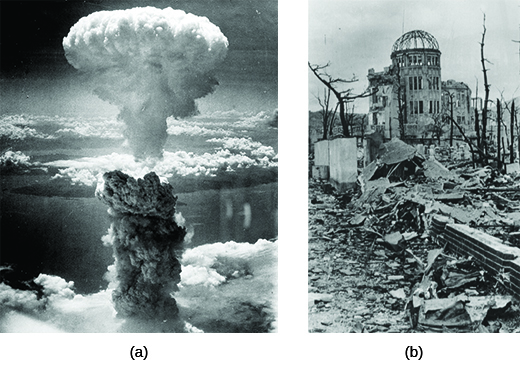| << Chapter < Page | Chapter >> Page > |

Visit the Atomic Bomb Museum site to read the accounts of survivors Hiroshi Morishita and Shizuko Nishimoto.
The decision to use nuclear weapons is widely debated. Why exactly did the United States deploy an atomic bomb? The fierce resistance that the Japanese forces mounted during their early campaigns led American planners to believe that any invasion of the Japanese home islands would be exceedingly bloody. According to some estimates, as many as 250,000 Americans might die in securing a final victory. Such considerations undoubtedly influenced President Truman’s decision. Truman, who had not known about the Manhattan Project until Roosevelt’s death, also may not have realized how truly destructive it was. Indeed, some of the scientists who had built the bomb were surprised by its power. One question that has not been fully answered is why the United States dropped the second bomb on Nagasaki. As some scholars have noted, if Truman’s intention was to eliminate the need for a home island invasion, he could have given Japan more time to respond after bombing Hiroshima. He did not, however. The second bombing may have been intended to send a message to Stalin, who was becoming intransigent regarding postwar Europe. If it is indeed true that Truman had political motivations for using the bombs, then the destruction of Nagasaki might have been the first salvo of the Cold War with the Soviet Union. And yet, other historians have pointed out that the war had unleashed such massive atrocities against civilians by all belligerents—the United States included—that by the summer of 1945, the president no longer needed any particular reason to use his entire nuclear arsenal.
Whatever the true reasons for their use, the bombs had the desired effect of getting Japan to surrender. Even before the atomic attacks, the conventional bombings of Japan, the defeat of its forces in the field, and the entry of the Soviet Union into the war had convinced the Imperial Council that they had to end the war. They had hoped to negotiate the terms of the peace, but Emperor Hirohito intervened after the destruction of Nagasaki and accepted unconditional surrender. Although many Japanese shuddered at the humiliation of defeat, most were relieved that the war was over. Japan’s industries and cities had been thoroughly destroyed, and the immediate future looked bleak as they awaited their fate at the hands of the American occupation forces.
The victors had yet another nation to rebuild and reform, but the war was finally over. Following the surrender, the Japanese colony of Korea was divided along the thirty-eighth parallel; the Soviet Union was given control of the northern half and the United States was given control of the southern portion. In Europe, as had been agreed upon at a meeting of the Allies in Potsdam in the summer of 1945, Germany was divided into four occupation zones that would be controlled by Britain, France, the Soviet Union, and the United States, respectively. The city of Berlin was similarly split into four. Plans were made to prosecute war criminals in both Japan and Germany. In October 1945, the United Nations was created. People around the world celebrated the end of the conflict, but America’s use of atomic bombs and disagreements between the United States and the Soviet Union at Yalta and Potsdam would contribute to ongoing instability in the postwar world.
The way in which the United States fought the war in the Pacific was fueled by fear of Japanese imperialistic aggression, as well as anger over Japan’s attack on Pearl Harbor and its mistreatment of its enemies. It was also influenced by a long history of American racism towards Asians that dated back to the nineteenth century. From hostile anti-Japanese propaganda to the use of two atomic bombs on Japanese cities, America’s actions during the Pacific campaign were far more aggressive than they were in the European theater. Using the strategy of island hopping, the United States was able to get within striking distance of Japan. Only once they adopted this strategy were the Allied troops able to turn the tide against what had been a series of challenging Japanese victories. The war ended with Japan’s surrender.
The combined Allied forces had successfully waged a crusade against Nazi Germany, Italy, and Japan. The United States, forced to abandon a policy of nonintervention outside the Western Hemisphere, had been able to mobilize itself and produce the weapons and the warriors necessary to defeat its enemies. Following World War II, America would never again retreat from the global stage, and its early mastery of nuclear weapons would make it the dominant force in the postwar world.

Notification Switch
Would you like to follow the 'U.s. history' conversation and receive update notifications?